Hay
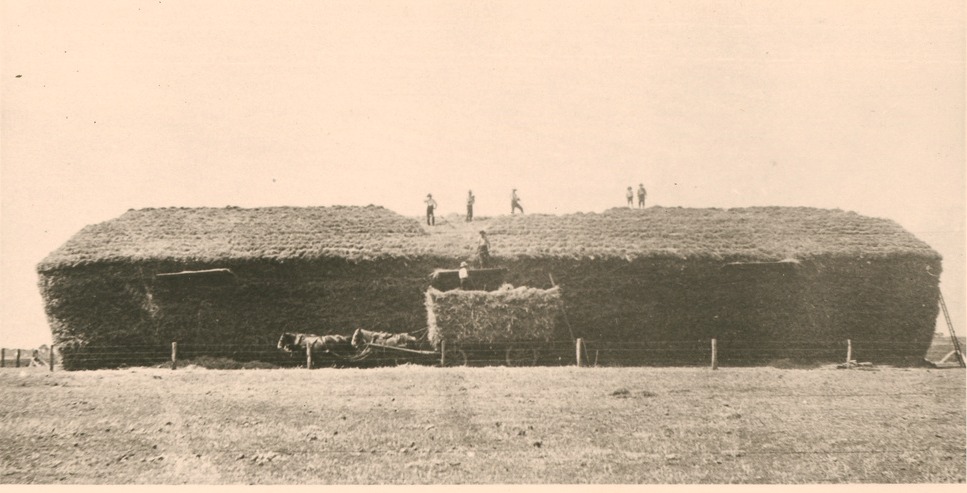
Waler Data Base @ Facebook. Image: … large hay stack c. 1900…. State Library S.A.
We learn so much from our followers on Facebook, comments soon flow about photographs posted. Correcting captions that are archived with the photos we post, explaining more, and adding personal stories and photographs on the topic being covered.
Take the topic of hay for example. Some people call dried grass “hay” and call the stalks of a grain crop “straw”, but the term “hay” is used for both by many. Straw has no grain/heads and hay does. There you go!
From John Boag’s comment on photo below: “My father and grandfather always cut enough wheaten hay each year to fill 2 very large haysheds. The hay was in sheaves as per photo and was cut when in head, but still green, the grain had not properly formed. The sheaves were formed into stooks of about 1/2 dozen sheaves to dry, usually by us kids. When dry, like wagons were pulled into the paddock and the sheaves collected and transferred to the haystacks. My grandfather had his own chaff cutter and we had regular days converting hay sheaves to chaff, which he supplied to the local pony club, show society, individuals and of course, the local coal mine where pit horses were still in use.
Of course much of this hay was used on farm for cattle and horse fodder. The milk cows were given a mixture of chaff and grain while being milked which helped milk production.
There is reference in this thread about snakes settling in the stooked hay. So true, happened often. At days end, all hard, satisfying work, even for us kids who were always involved.“
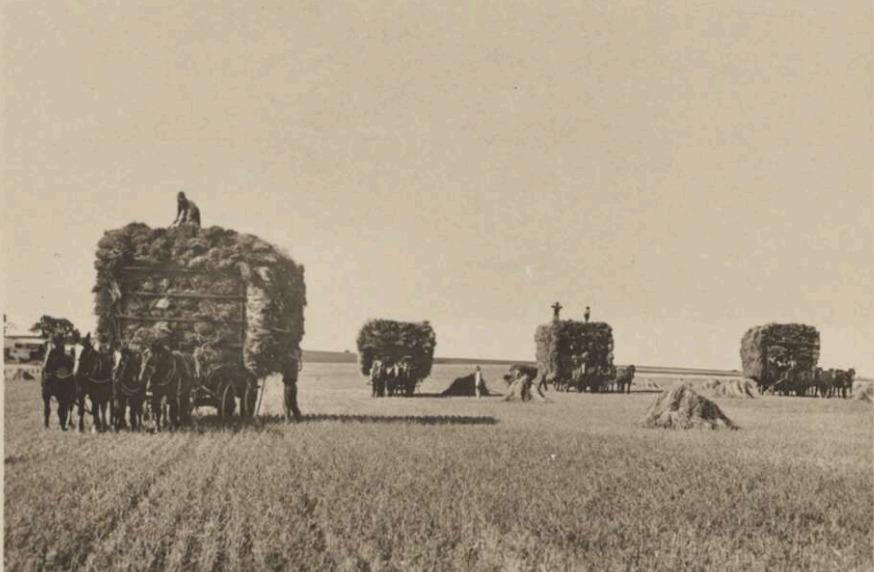
Wheat was grown on Tuela, the property owned by Mr. Coleman. The wheaten hay/straw was carted by contractors in this photo, Crawford Bros., who were also farmers. The grain is still on the heads so it’s a heavy load.
Wheat was also grown by the Crawford Bros. on their own place, for example in 1929 the variety called Waratah – cutting two tons of wheaten hay to the acre. That year Mr Coleman experimented with a variety called Rajah.
Crawford Bros (R.S. and T.J. Crawford) also showed draught horses, for example in 1914 at Saddleworth in the mid northwest of South Australia; and in 1917 paying good money for a stallion named Mountain Lad at the Kapunda horse sales. Their own property was Miuana, 1,050 acres. They’d moved there from Gippsland approx 1912. In 1926 they lost 80 acres of wheat to a bushfire.
Crawford Bros. grew everything without irrigation. At Forbes Show in 1913 they exhibited several things including Leicester sheep, the hide of a big yearling steer made into fine leather, some beautiful blacksmith work by R.S. – they had a forge at home on Miuana and he’d made a miniature plough, some horseshoes and a small anvil to exhibit as well as preserves, pickles, apples, vegetables, tallow, soft wheat and more, all from the farm. They grew wheat variety Federation that year cutting 6 bags to the acre.
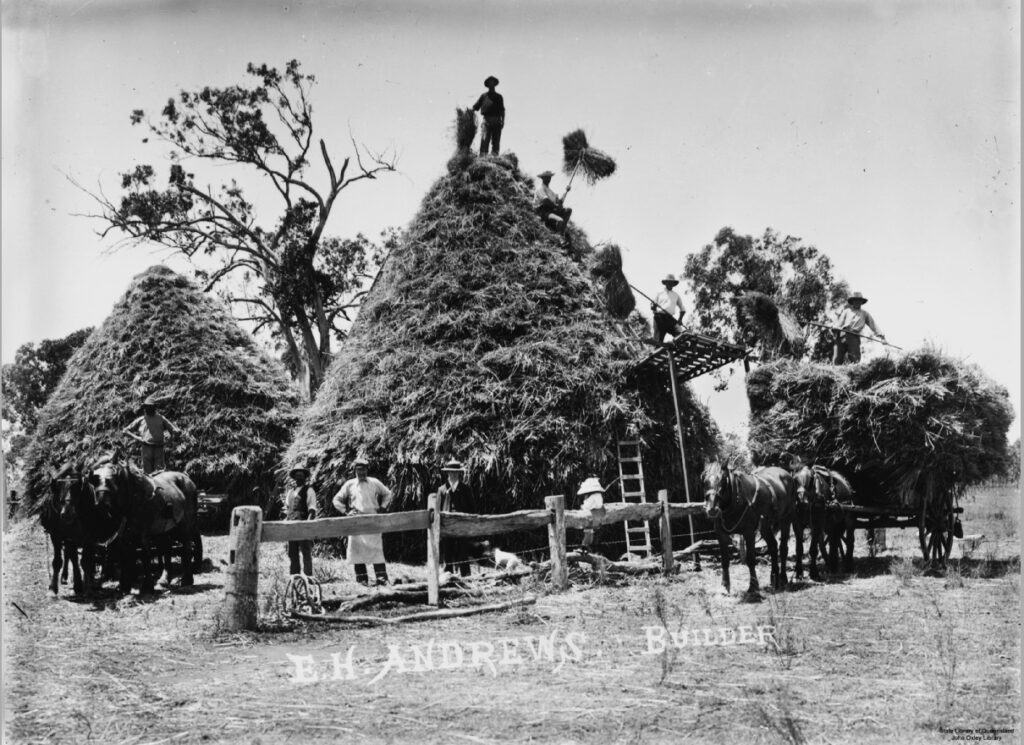
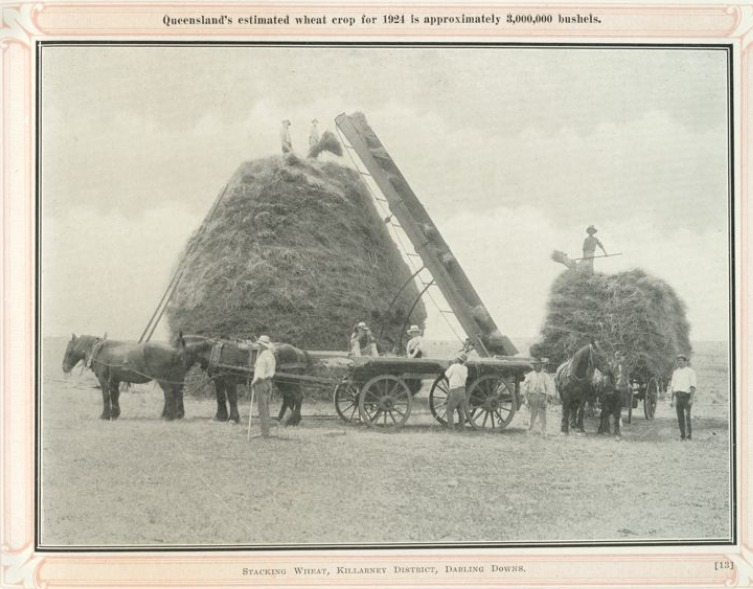
Images: Farm workers are using pitch forks to unload hay… caption E.H. Andrews, builder. State Library Qld; Loading wheat from the hay wagons to the stacks, Killarney district on the Darling Downs, ca. 1924. State Library S.A.
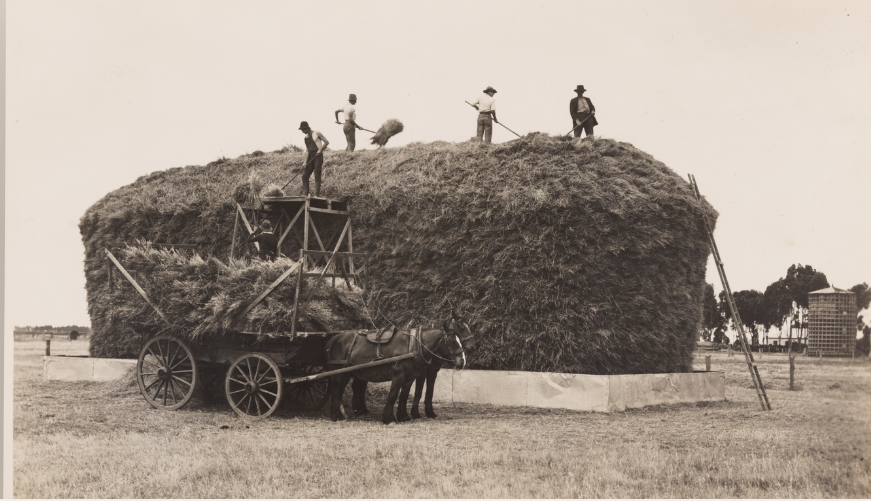
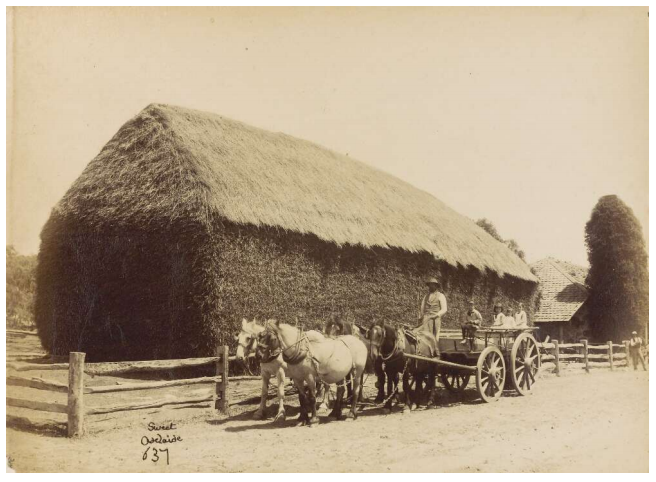
Images: Large haystack being built, 1921-24. State Library NSW; Four unidentified children and one adult in cart in front of haystack, South Australia, ca. 1870s?. Photo taken by Samuel White Sweet Samuel White (1825-1886). National Library of Australia.
Stooks meant putting stalks, usually of a grain or grass hay crop, into upright bunches. Heads of grain on top – this kept the grain-heads dry, clean and intact until threshed to remove grain. It was cut down to be stooked by a reaper. The reaper usually had a binder too, which automatically tied the stalks into sheaves.
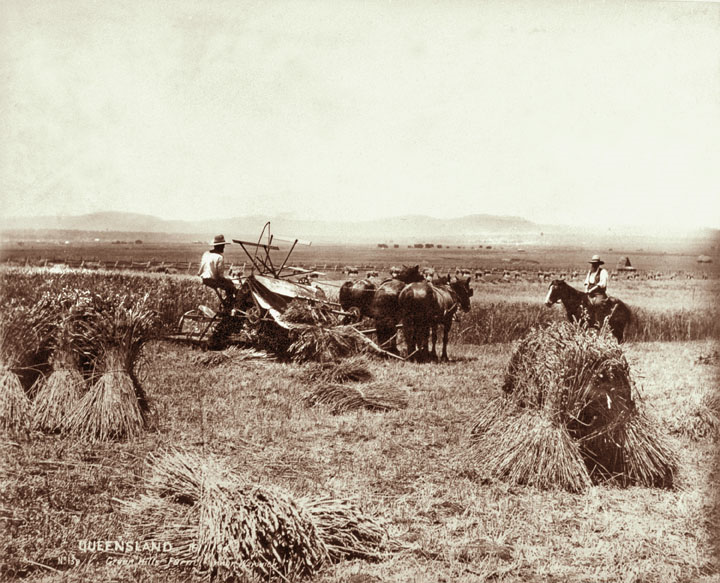
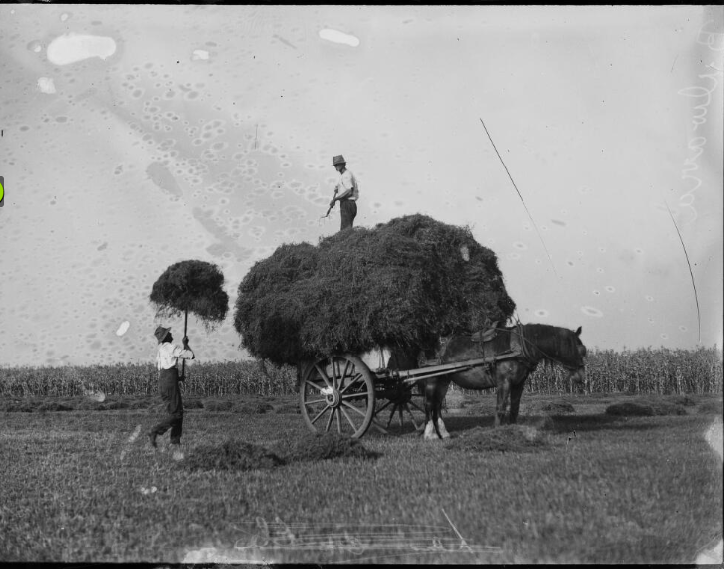
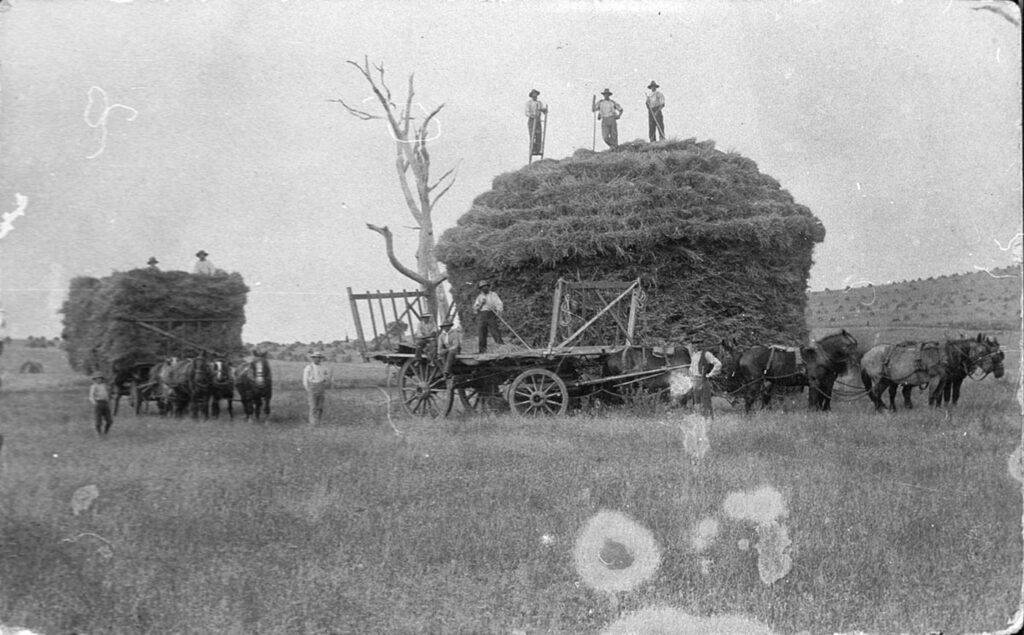
Images: Reaper, binder and stooks at Green Hills Farm near Warwick, 16 November 1894. Queensland State Archives; Men loading harvested hay onto a horse drawn cart at Bulwarra, New South Wales, ca. 1920s. National Archives of Australia; Carting in hay with two teams. Notice stooked hay in distance – Near Mandurama, NSW. Undated. State Library NSW.
Then people came along stooking – standing the sheaves up to dry by leaning them together – these little groups of standing sheaves are called stooks.
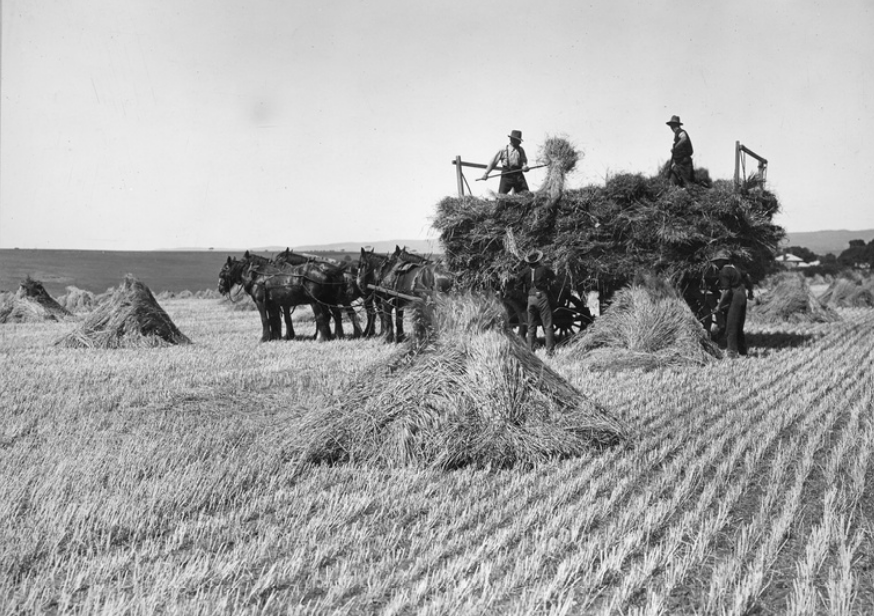
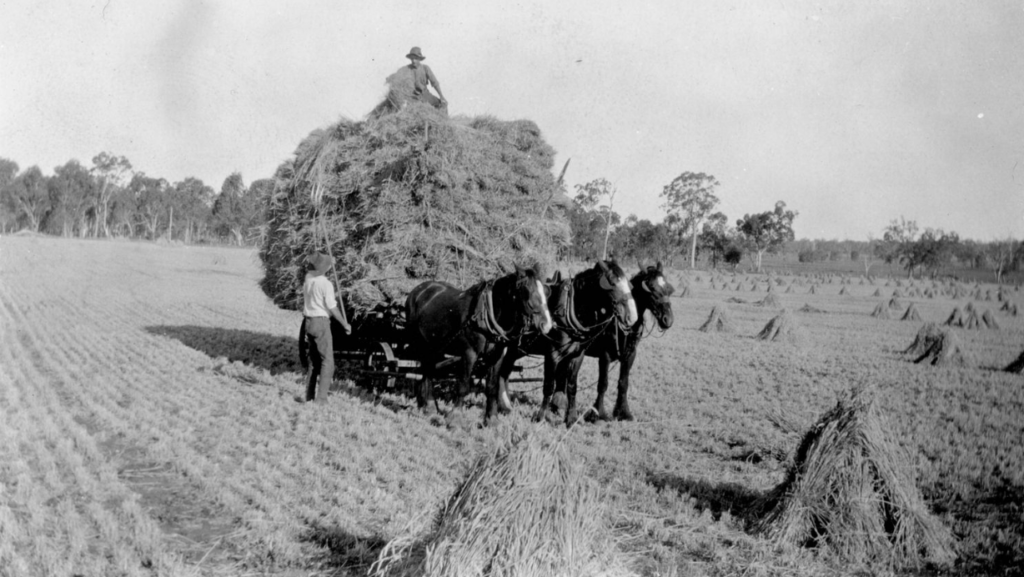
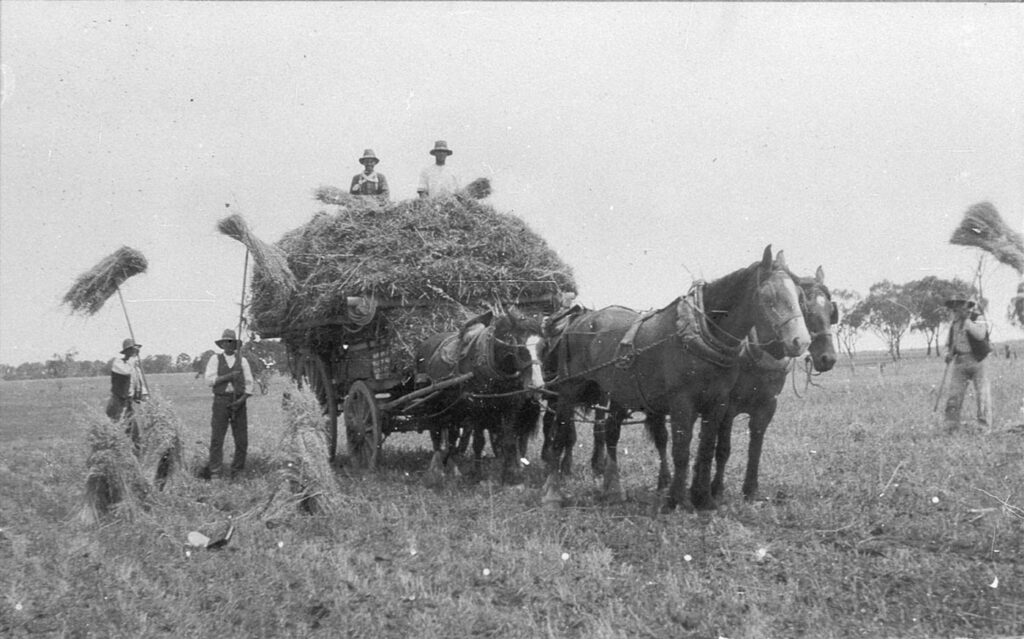
Images: Haymaking near Willunga showing men pitching and stacking sheaves of hay onto horse drawn wagon. 1950, State Library of SA; Hay carting at Riverleigh, Chinchilla, Queensland, 1930. State Library of Qld; Loading stooks of wheat onto cart at Wellington Vale – Deepwater, NSW. 1915. State Library NSW.
Sheaves of grass for hay was often stooked to dry, before the stooks were picked up and stacked into a giant, carefully made stook – which we now call a haystack; once also called a stook.
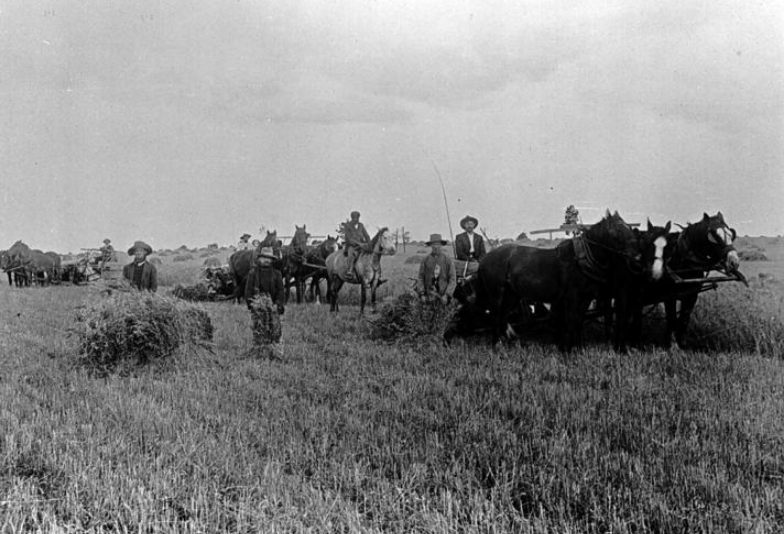
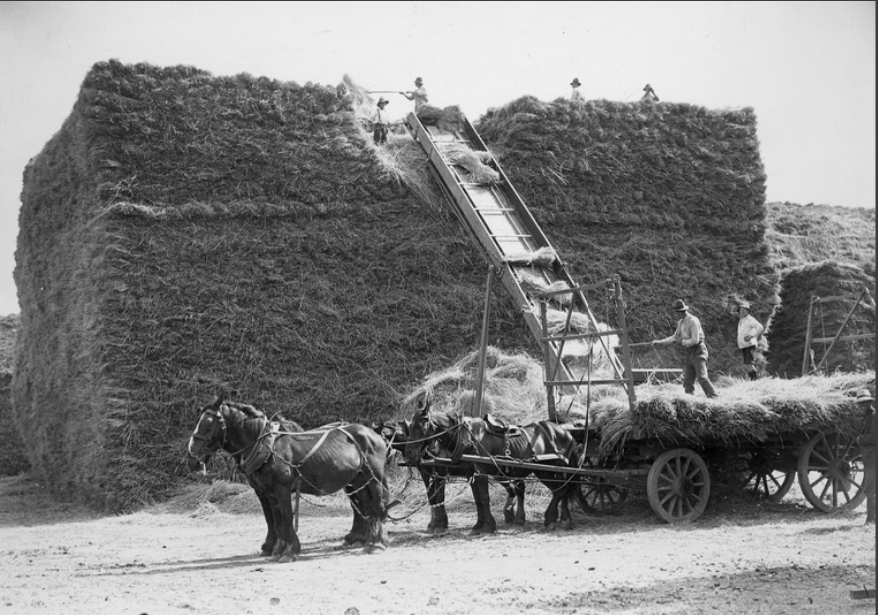
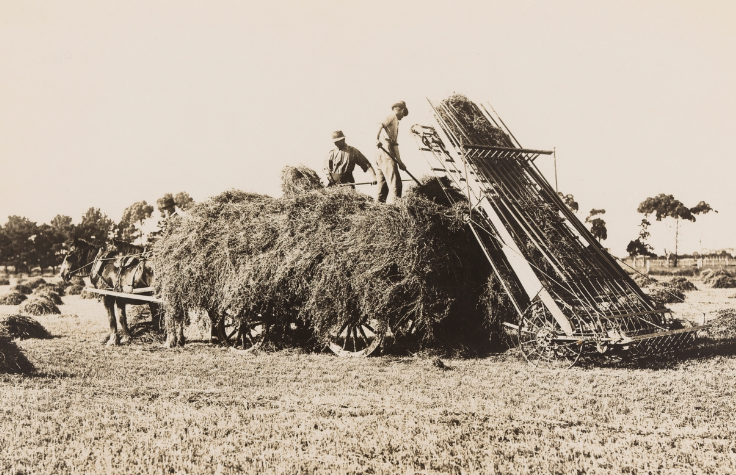
Images: Group Stooking Sheaves of Hay, Hopetoun, Victoria, circa 1895. Photo by Edgar Evans Museums Vic; Stacking hay by elevator at Salisbury… c. 1950. State Library SA; Loading hay with help, dated 1921-24. State Library NSW.
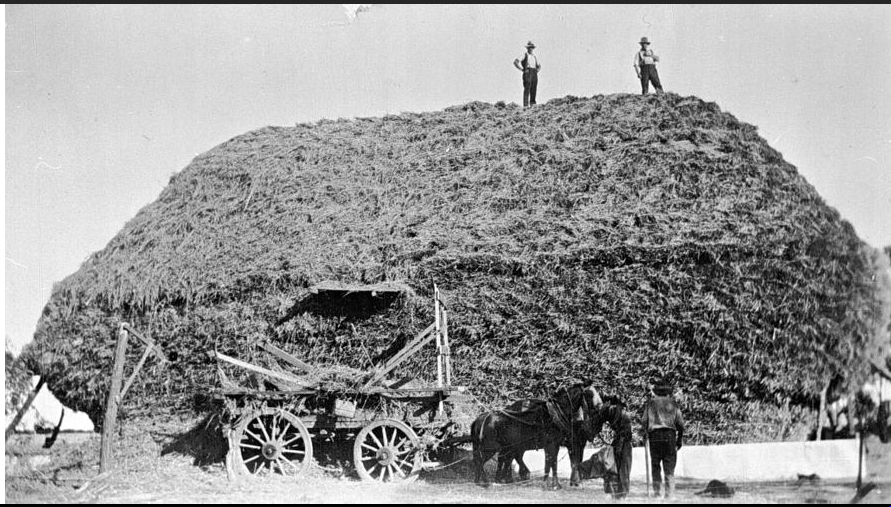
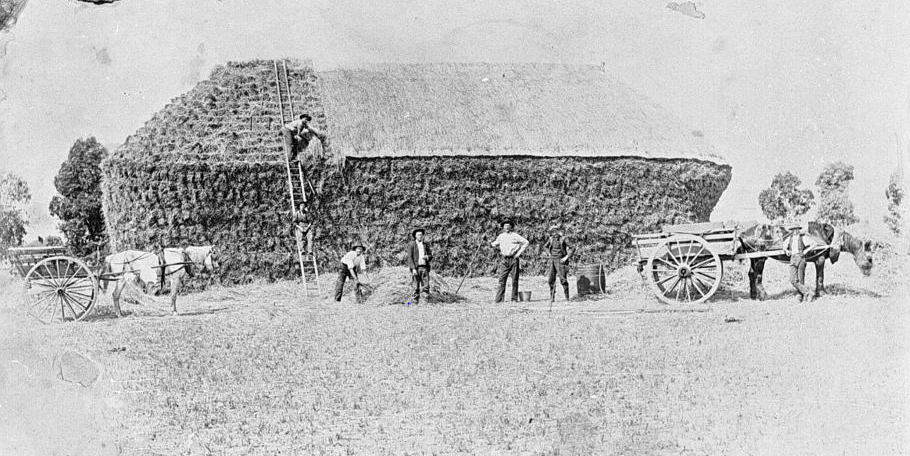
Images: Building a giant haystack, Glengower, near Creswick, 1939. The haystack is surrounded by a mouse proof fence. Photo by Daphne B. Jones, 1939.’ Museums Victoria; ‘Men Thatching Haystack, Creswick District, Victoria, 1910.’ Museums Victoria.
So – sheaf, stook, stack.
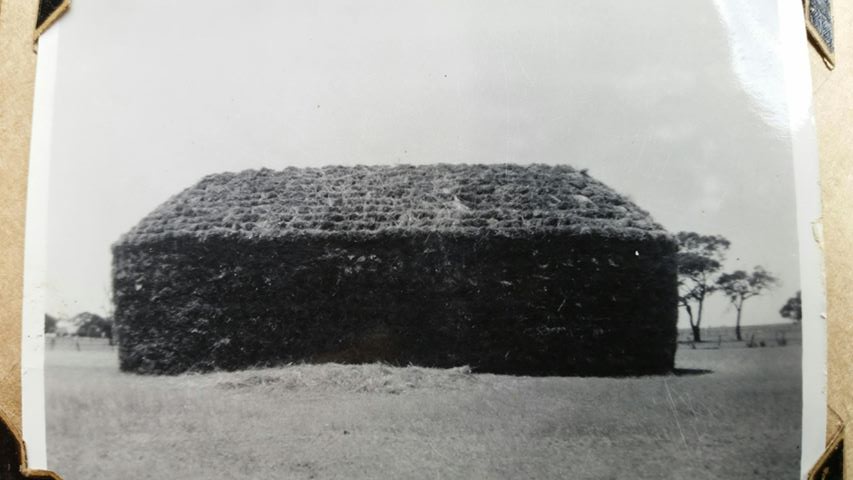
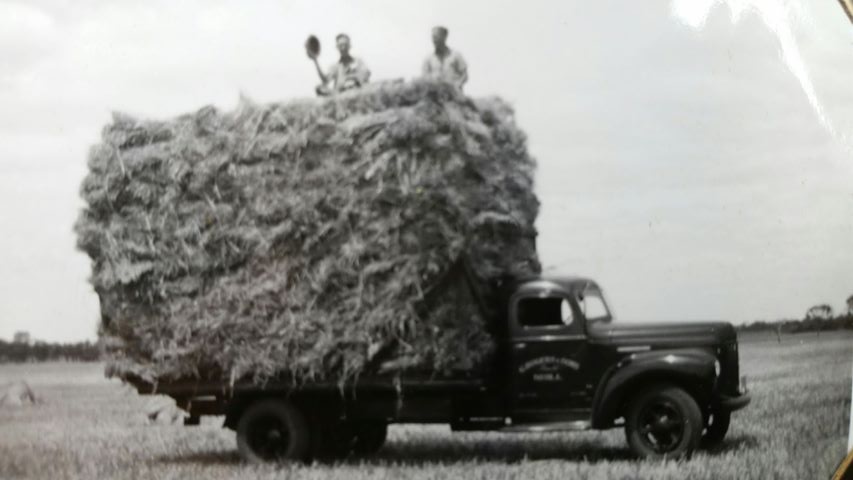
Images: Janice Merrett family photo of a haystack her father and his brothers made. It was measured and estimated to be 200 tonnes. The sheaves were stacked onto their truck for delivery to Melbourne. It took several truckloads and when tallied up, yes the weight was indeed 200 tonnes!
Hay was also made from the stalks of wheat, oats, barley etc (usually called straw in more agriculturally rich areas, where hay means grass, often with some legumes mixed in the pasture, such as vetch. In drier areas hay can mean straw – that is, the stalks of plants used primarily for grain).
If the grain heads were removed from the stalks before stooking, straight from crop while standing untouched in the paddock, this was because a header was used to precisely cut the heads off. Needless to say as the grain was taken off, it also had to feed into a container. After heading, the stalks were slashed, then stooked to dry for cattle, sheep and horse fodder or stable bedding. Sometimes burned, sometimes ploughed back in, but usually treated as a crop in themselves.
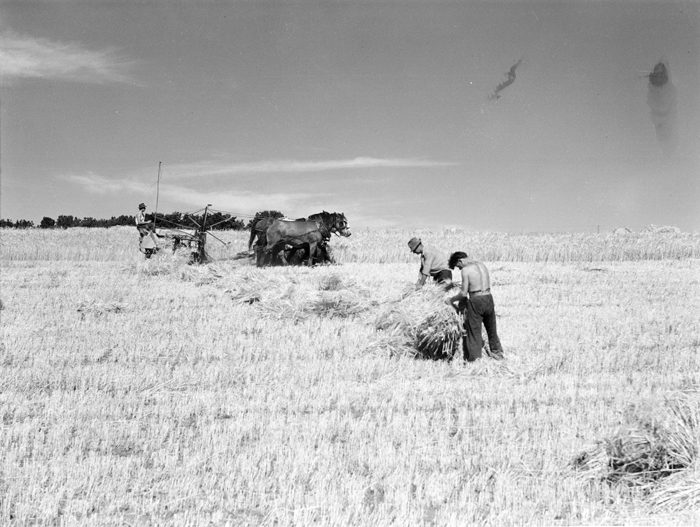
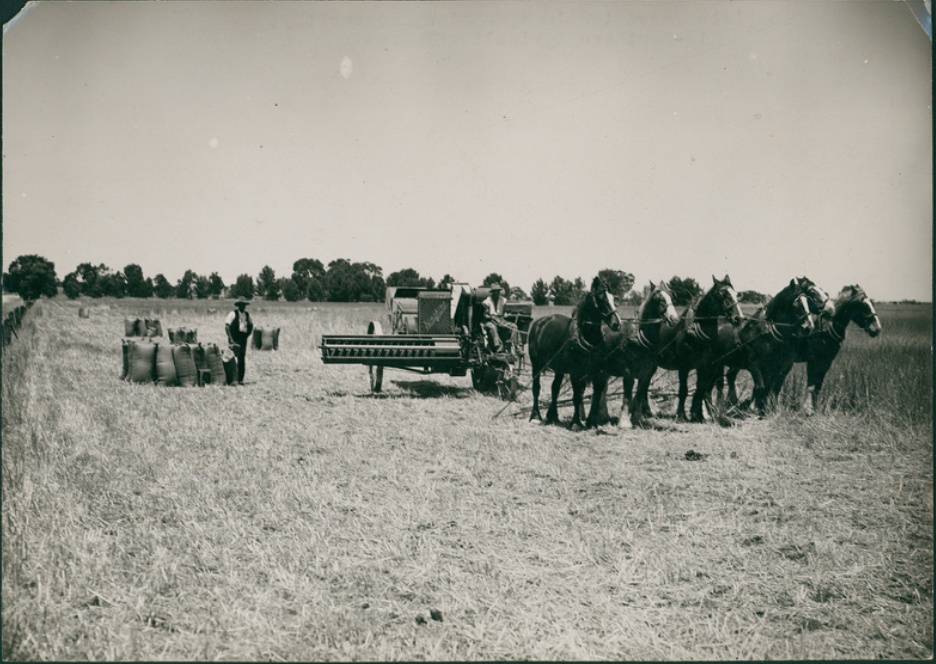
Images: Cutting and stooking barley at Rippledale, Victoria. 1945. National Archives of Australia; ”Sunshine” Wheat Harvester at work. This harvester is pulled by a team of six horses. Sacks of wheat are stacked on the ground ready to be collected. c. 1920. No location other than South Australia. State Library of S.A.
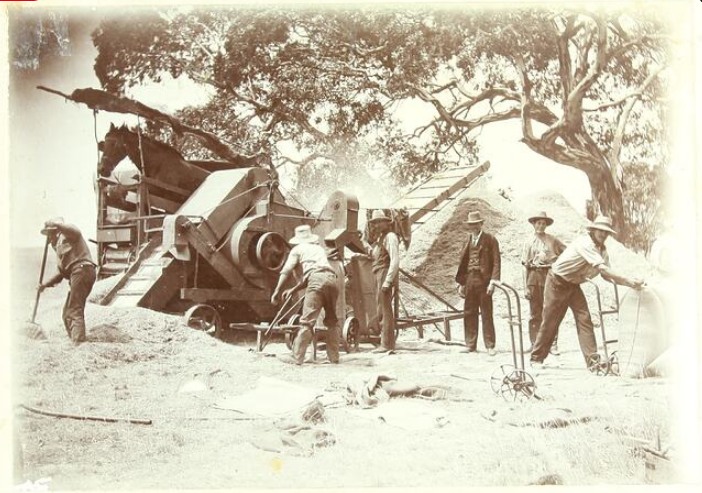
Image and caption: Museums Victoria
‘Processing a wheat crop, using a horse treadmill operating a winnowing machine that is processing a cereal crop, circa 1900.
… a typical ‘Mallee country’ harvesting scene of period c.1880s-1915.
Shown in the scene are a horse treadmill operating a winnowing machine that is processing a cereal crop that would have initially been removed with a stripper. This image is particularly impressive with the level of detail shown in the photo (such as the bag trollies, workers, etc) and the clarity and obvious professional composition of the views.
Although the photograph was taken in South Australia, it shows a scene and type of technology that was typical of farms in the Mallee country of both Victoria and South Australia.’